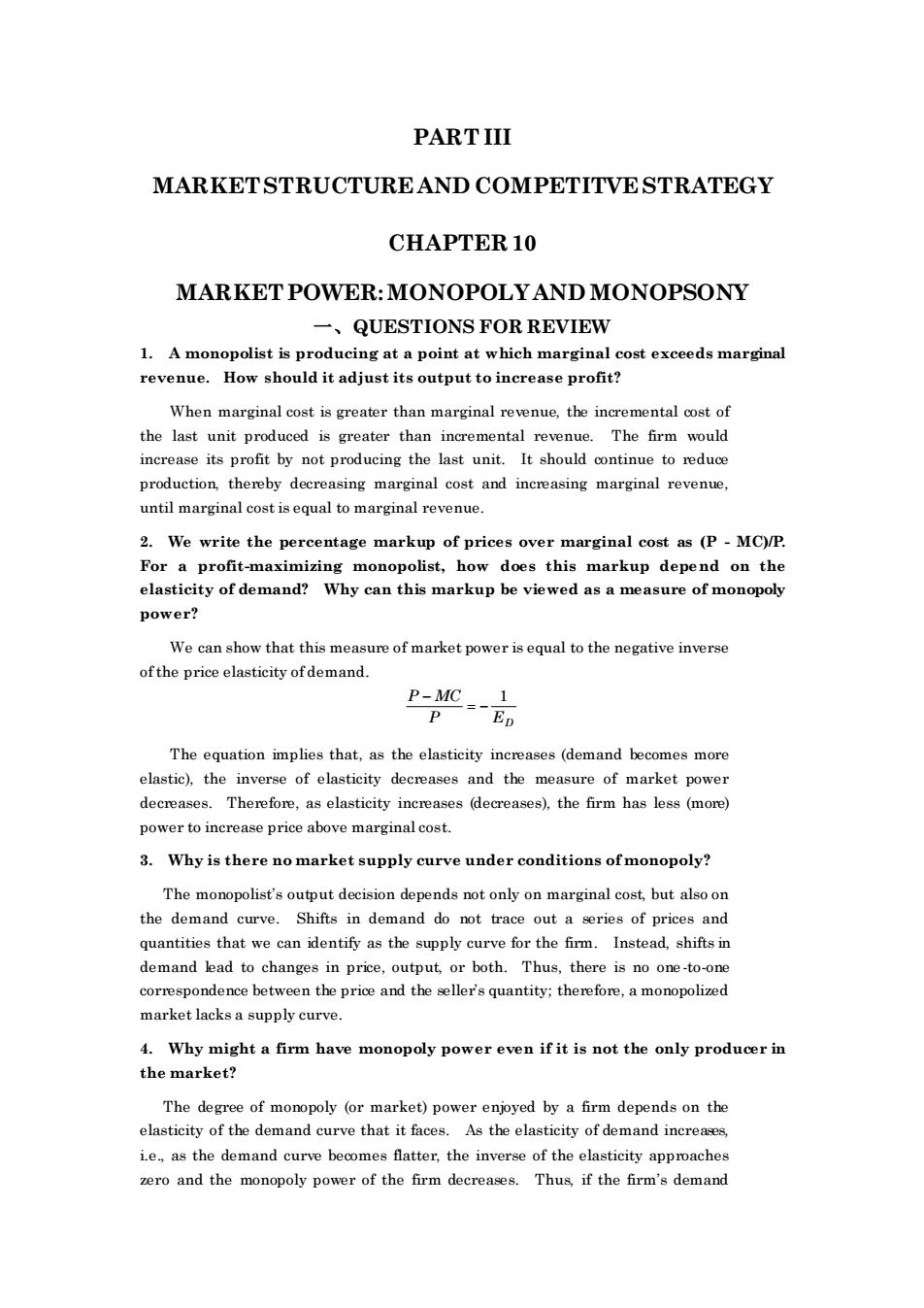正在加载图片...

PARTIII MARKETSTRUCTUREAND COMPETITVESTRATEGY CHAPTER 10 MARKETPOWER:MONOPOLYAND MONOPSONY -QUESTIONS FOR REVIEW 1.A monopolist is producing at a point at which marginal cost exceeds marginal revenue.How should it adjust its output to increase profit? When marginal cost is greater than marginal revenue,the incremental oost of the last unit produced is greater than incre mental revenue.The firm would production thereby decreasing marginal cost and increasing marginal revenue until marginal cost is equal to marginal revenue. 2.We write the percentage markup of prices over marginal cost as (P-MC)/P. For a profit-maximizing monopolist,how does this markup depend on the elasticity of demand?Why can this markup be viewed as a measure of monopoly We can show that this mea ure of market power is equal to the negative inverse p-C- The equation implies that,as the elasticity increases(demand becomes more elastic).the inverse of elasticity decreases and the measure of market power decreases.Therefore,as elasticity increases (decreases),the firm has less(more) power to increase price above marginal cost 3.Why is there no market supply curve under conditions ofmonopoly? The monopolist's output decision depends not only on marginal cost,but alsoo the demand curve.Shifts in demand do not trace out a series of prices and quantities that we can identify as the supply curve for the firm.Instead,shifts in demand lead to changes in price.output,or both.Thus,there is no one-to-one orrespondence between the price and quantity:therefore,a monopolized market lacks a supply curve. 4.Why might a firm have monopoly power even ifit is not the only producer in the market? The degree of monopoly(or market)power enjoyed by a firm depends on the elasticity of the demand curve that it faces.As the elasticity of demand increaes ie.as the demand curve becomes flatter,the inverse of the elasticity appraches ero and the monopoly power of the firm decreases.Thus if the firm's demandPART III MARKET STRUCTURE AND COMPETITVE STRATEGY CHAPTER 10 MARKET POWER: MONOPOLY AND MONOPSONY 一、QUESTIONS FOR REVIEW 1. A monopolist is producing at a point at which marginal cost exceeds marginal revenue. How should it adjust its output to increase profit? When marginal cost is greater than marginal revenue, the incremental cost of the last unit produced is greater than incremental revenue. The firm would increase its profit by not producing the last unit. It should continue to reduce production, thereby decreasing marginal cost and increasing marginal revenue, until marginal cost is equal to marginal revenue. 2. We write the percentage markup of prices over marginal cost as (P - MC)/P. For a profit-maximizing monopolist, how does this markup depend on the elasticity of demand? Why can this markup be viewed as a measure of monopoly power? We can show that this measure of market power is equal to the negative inverse of the price elasticity of demand. P MC P ED − = − 1 The equation implies that, as the elasticity increases (demand becomes more elastic), the inverse of elasticity decreases and the measure of market power decreases. Therefore, as elasticity increases (decreases), the firm has less (more) power to increase price above marginal cost. 3. Why is there no market supply curve under conditions of monopoly? The monopolist’s output decision depends not only on marginal cost, but also on the demand curve. Shifts in demand do not trace out a series of prices and quantities that we can identify as the supply curve for the firm. Instead, shifts in demand lead to changes in price, output, or both. Thus, there is no one -to-one correspondence between the price and the seller’s quantity; therefore, a monopolized market lacks a supply curve. 4. Why might a firm have monopoly power even if it is not the only producer in the market? The degree of monopoly (or market) power enjoyed by a firm depends on the elasticity of the demand curve that it faces. As the elasticity of demand increases, i.e., as the demand curve becomes flatter, the inverse of the elasticity approaches zero and the monopoly power of the firm decreases. Thus, if the firm’s demand